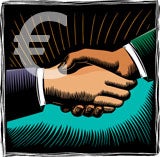Not long ago, markets in Europe and the U.S. reacted with alarm when some countries that had long been the target of corporate takeovers, such as Spain, launched their own international takeovers. Now new alarm bells are sounding in Europe, especially in countries that are conservative and protectionist. That’s because Indian entrepreneurs are now launching such takeovers. As a result, figures such as Lakshmi Mittal and Ratan Tata are beginning to attract significant attention in the European media.
Although Chinese companies are making a strong push into global markets, their executives have yet to achieve the fame recently won in Europe by such Indian executives as Lakshmi Mittal, who took control of the steel consortium Arcelor, and Ratan Tata, who is trying to buy Corus, the Anglo-Dutch steelmaker. These are some of the best known names, but they are hardly the only ones. In the near future, such figures as Anil D. Ambani, president of Reliance, and Sunil Bharti Mittal, founder of Bharti, will become very well-known in Europe. Their faces will occupy the same front pages as Emilio Botin, president of Santander, who bought the British bank Abbey, and Amancio Ortega, founder of the Zara fashion group, who has opened branches around the world.
Sanjay Peters, a professor in Esade’s economics department, says that in addition to these figures, other Indian executives are playing a major role in big multinationals, such as Arun Sarin, chief executive of Vodafone, and Sanjiv Ahuja, chief executive of Orange. Both of these companies provide mobile phone services. In other cases, Indian managers have risen to the top of Western companies, such as Indra Nooyi, CEO of PepsiCo. “It’s not just that Indian executives have an amazing presence in foreign companies, but also that they have such a presence in the most prestigious universities of the world, such as Harvard in the U.S. and Cambridge in the U.K.,” says Peters. In the academic world, more and more Indians are acquiring a higher profile. Examples include C.K. Prahalad, a well-known strategy guru, and Das Narayandas, an expert in international marketing.
Why are Indian companies undergoing a process of globalization? Although many have had a presence in the U.S. markets for several years, their appearance in Europe has been a more recent phenomenon. According to Juan Carlos Martínez Lázaro, a professor at the Instituto de Empresa (IE), the Madrid-based business school, “These companies are already large enough in the India market, so they need to expand…. Usually, they operate in those sectors where size is important, such as steelmaking, and where they can take advantage of economies of scale in order to lower their costs,” he notes.
Although it may still seem strange that Indian conglomerates are buying European companies, Martinez Lázaro suggests that this is a logical development, and that the same process is beginning to happen with Chinese companies. The first step usually involves making an acquisition in the United States “because it is easier to operate there,” given the bureaucratic barriers in other countries. The next step is to grow in Europe — a trend that will accelerate over the next few years, says Martínez Lázaro.
Characteristics of Asian Entrepreneurs
One of the great advantages of Indian executives, compared with their Chinese counterparts, is their knowledge of Anglo-American culture. Another advantage is the greater openness that India has enjoyed when it comes to foreign capital, notes Pedro Moreno de los Ríos, a partner at Parangon Partners, an executive search firm. Indian managers tend to have an international approach, and “India is [even] exporting managers to China.” When it comes to multinationals, local Indian executives are part of the cadre of new executives who are promoted within the company and move up to headquarters. They bring a multicultural character to these companies, breaking the stereotype that only Americans become chief executives of large global companies.
This viewpoint is shared by John J. Grumbar, the new president of Egon Zhender International, the executive search company. A significant number of Indians have “a lot of talent” and need only to broaden their goals and study abroad, he says. When they finish their training, they return to India ready to take advantage of the opportunities and potential of that country. Indians also bring their knowledge of the English language and the Anglo-American business style, inherited from the British colonial era. This is one of the major differences from China, where it is very hard for a foreigner to join a local company because of language problems and because of a very hierarchical structure that is “too paternalistic,” says Grumbar. As recently as 25 years ago, the law even prohibited companies in China from recruiting employees who were working in other companies.
According to Martínez Lázaro, the big Indian companies pushing their way into Europe have already spent quite a lot of time operating in the West. As a result, “they have adapted perfectly to the rules of the game here.” In addition, they have had to comply with the same norms and codes of good governance as their competitors in order to list their shares on [Western] stock markets. Nevertheless, Martínez Lázaro recognizes that “the Indian way of doing business is quite different.” For example, Indian business culture is based on trust, while business in Europe is more impersonal. “Here, the contract is the law, while in India, there are times when your word and personal relationships are more important than the actual contract,” he notes.
Peters points out that things have changed a great deal in India over the last two decades, and so have the characteristics of the typical [Indian] business leader. He notes that there are some families that have a long tradition of doing business, where a new generation of leaders is pushing to find their own place in the sun through hard work and tenacity. In India, says Peters, there are a lot of family-owned industrial firms, and some “even pre-date the colonial period” of British rule.
Nevertheless, some small, family-owned companies have become truly large enterprises now considered among the largest industrial firms in the country. Examples include the Tata Group, Mahindra & Mahindra, Birla Group and Reliance. In many of these cases, notes Peters, the portion of the company owned by family members has been diluted. In part, that’s because minority shareholders now have a great deal of weight and influence within the company, which has become “totally professionalized” from the corporate point of view.
On the other hand, a new group of business leaders has emerged over the past two decades, according to Peters. Some are in “companies that have not relied on any support from the government,” while others came from a small elite that received support from the government. In his opinion, both groups of entrepreneurs have learned how to take advantage of opportunities in a “country that is no longer agricultural,” and where they can provide a significant boost to the service sector. Perhaps the most familiar case involves Narayana Murthy, founder of Infosys, one of India’s top software firms. According to Peters, there is only one Bill Gates in the U.S., but many similar figures are emerging in India. Gates launched his company in his garage, assembling computers. For his part, Murthy sold all of his belongings, even his mother’s jewelry, to establish a company that now competes with the computer giant.
According to Peters, the names of an entire new generation of young business leaders is emerging on the international landscape, and other names will do so over the next few years. “What is special about them is that they have managed to create large companies through their own sweat,” not because of outside help or sponsorship from large families. Many have studied in Indian universities, but others have gone abroad and later returned. Some have earned an MBA in a prestigious business school. No matter what their area of activity, they are ready to take advantage of the opportunities that India offers, so their companies can grow. Ranbaxy, Dr. Reddys Lab, Satyam and Wipro are only some of the names that will start to appear on the front pages of the global press in coming months, Peters predicts.
Diversification Style
One thing that may surprise European and American executives is the way both traditional and new Indian companies channel their energy. For example, it is hard to put all of their company’s activities into a single sector. Consider the Tata Group, which owns steel plants but also operates an automobile division, and also owns Tata Consultancy Services, the largest IT consulting firm in India. The holdings of The Reliance group, which has one of the highest market capitalizations in Asia, range from the telecommunications sector to companies that supply electricity. Bharti Tele-Ventures, one of the largest mobile telephone companies in India, has also reached an agreement with Wal-Mart to open a chain of supermarkets throughout India.
To take advantage of such opportunities, these new executives must find sources of financing, including foreign sources of capital. “They are aware that there are markets that have not been exploited, and they want to take advantage of them, but not if foreigners get 100% of the profits,” says Peters, adding that “this way, they guarantee that India will not be sold off to foreigners.” He says India will keep its doors open while maintaining control and participating in its own development. “India wants to create its own companies and brands, while China leaves the road wide open to foreign companies,” says Peters.
Tata, Reliance and Bharti
One example of an Indian business leader who has long been famous in India but is now beginning to be known internationally is Ratan Tata, who inherited the business empire founded by his ancestor Jamsetji Tata in the second half of the 19th century. Currently, Tata Group comprises about 80 companies. When Ratan Tata inherited the title in 1991, the holding company had more than 300 companies, which the company controlled through trusts that, in most cases, did not provide Tata with ownership of more than five percent. Ratan Tata decided to reorganize the group and increase its ownership and influence in those companies that the Tata holding company still owned.
To do that, Tata gave up many companies in such sectors as textiles, and focused on other areas, such as automobiles. In so doing, the Tata holding company continued to grow, and became the largest business conglomerate in the country. When India became too small for the Tata group, Ratan Tata decided to make a great leap outside India. In 2000, he bought Britain’s Tetley Tea for $435 million. Some experts described the deal as the first great foreign acquisition made by any Indian company.
Nowadays, Tata has been in the news not only for trying to buy the Anglo-Dutch steelmaker Corus, but also for Tata Motors, which manufactures economy cars. Although some people have doubts about this approach to doing business, it is the family legacy of the Tatas. In 1904, Jamsetji Tata, who founded the company, decided to construct the Taj Mahal Hotel in Bombay because, as an Indian, he was not allowed to enter any hotel in that city. The hotel was the first building in the city that used electricity and the first hotel with American fans, German elevators, Turkish baths and English servants, among other novelties of the era. In short, Tata turned adversity into an opportunity. (Editor’s note: This hotel is still going strong in Mumbai — and was the venue for the launch of the Indian edition of Knowledge at Wharton last month.)
The Reliance group is another fast-growing conglomerate, and its market capitalization is one of the highest among private-sector companies in India. Nevertheless, problems regarding succession have taken their toll on the company. Dhirubhai H. Ambani, who died in 2002, founded this giant firm, and he is also considered one of the fathers of capital markets in India, mainly because he opened the doors of the country’s stock market to other investors who did not belong to the country’s elite. In 2002, Reliance laid about 60,000 kilometers of fiber optic cable, bringing the digital era into a country where infrastructure continues to be the great challenge of the future. Ambani, a former schoolteacher, began his company with only $300, and was among India’s wealthiest people at the time of his death. After Dhirubhai’s demise, the Reliance Group was reorganized and is now managed by his two sons, Mukesh and Anil.
Under the Airtel brand, Bharti has more than 28 million cell phone customers. In addition to developing software for telecommunications, Bharti has diversified into other businesses, including exporting fresh agricultural produce to Europe and the U.S., with help from the Rothschild Group. Bharti also has a presence in the insurance business, in a partnership with AXA, a Paris-based provider of financial services. With Wal-Mart, Bharti will also create supermarkets throughout India. Bharti’s market capitalization has reached $25 billion, and it employs more than 30,000 people.
This sort of tale is beginning to become familiar in India — the story of an entrepreneur who has created his company by himself, with tenacity and a vision of the future. Sunil Bharti Mittal is the president and founder of the company. (He is not related to Lakshmi Mittal, the steel magnate.) In 1976, when he was only 18, Mittal founded his company, using $1,500 that he borrowed from his father. In those days, in order to set up a business, a new company had to acquire a license from the government, and Mittal used his license to import portable electric generators.
In 1992, when he was working for Siemens, he took advantage of the deregulation of India’s telecom sector, and bought licenses for both mobile and fixed-line telephone services. From that day forward, his company’s prospects have continued to expand rapidly. Now, if Bharti wants to expand through Europe, its only option will be a series of isolated acquisitions, rather than one large-scale takeover, because no free licenses for telephone services exist in European countries.



